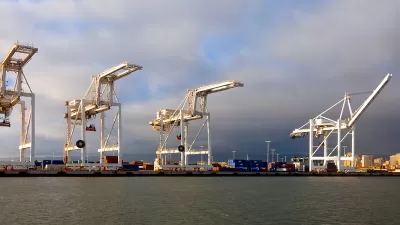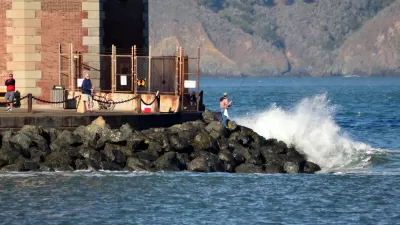Income inequality, housing affordability, and systemic racism join sea-level rise as key issues in Oakland's vision for urban resilience.

Like many resilience strategies, the Resilient Oakland Playbook outlines plans to prepare aging infrastructure for the drought conditions, increased wildfires, and sea-level rise that will likely impact the California city in the coming years.
But while climate impacts might be where some plans stop, Oakland has taken the approach that social and racial equity, an inclusive economy, and citizen empowerment are also crucial to the city’s overall sustainability.
"Our greatest barriers to resiliency are addressing our day-to-day social stresses, including equitable access to quality jobs, education, affordable housing, community safety and better infrastructure," Chief Resiliency Officer Kiran Jain told Next City.
Oakland does address these problems individually: The city has a goal of producing zero waste by 2020. It has taken steps to tackle its housing crisis, and recently launched its first Department of Transportation, which will take a complete streets approach to transportation planning. The state is also developing a regional plan to address sea-level rise in the Bay Area. The new "playbook" serves to connect separate departments under a common framework.
It is an element of the city’s participation in the Rockefeller Foundation’s 100 Resilient Cities (100RC) program, which provides cities worldwide technical support and funding for resiliency programs. Oakland hired its first chief resiliency officer through 100RC in 2014.
FULL STORY: Oakland Publishes Playbook for a Resilient Future

Alabama: Trump Terminates Settlements for Black Communities Harmed By Raw Sewage
Trump deemed the landmark civil rights agreement “illegal DEI and environmental justice policy.”

Study: Maui’s Plan to Convert Vacation Rentals to Long-Term Housing Could Cause Nearly $1 Billion Economic Loss
The plan would reduce visitor accommodation by 25% resulting in 1,900 jobs lost.

Why Should We Subsidize Public Transportation?
Many public transit agencies face financial stress due to rising costs, declining fare revenue, and declining subsidies. Transit advocates must provide a strong business case for increasing public transit funding.

Paris Bike Boom Leads to Steep Drop in Air Pollution
The French city’s air quality has improved dramatically in the past 20 years, coinciding with a growth in cycling.

Why Housing Costs More to Build in California Than in Texas
Hard costs like labor and materials combined with ‘soft’ costs such as permitting make building in the San Francisco Bay Area almost three times as costly as in Texas cities.

San Diego County Sees a Rise in Urban Coyotes
San Diego County experiences a rise in urban coyotes, as sightings become prevalent throughout its urban neighbourhoods and surrounding areas.
Urban Design for Planners 1: Software Tools
This six-course series explores essential urban design concepts using open source software and equips planners with the tools they need to participate fully in the urban design process.
Planning for Universal Design
Learn the tools for implementing Universal Design in planning regulations.
Smith Gee Studio
Alamo Area Metropolitan Planning Organization
City of Santa Clarita
Institute for Housing and Urban Development Studies (IHS)
City of Grandview
Harvard GSD Executive Education
Toledo-Lucas County Plan Commissions
Salt Lake City
NYU Wagner Graduate School of Public Service




























